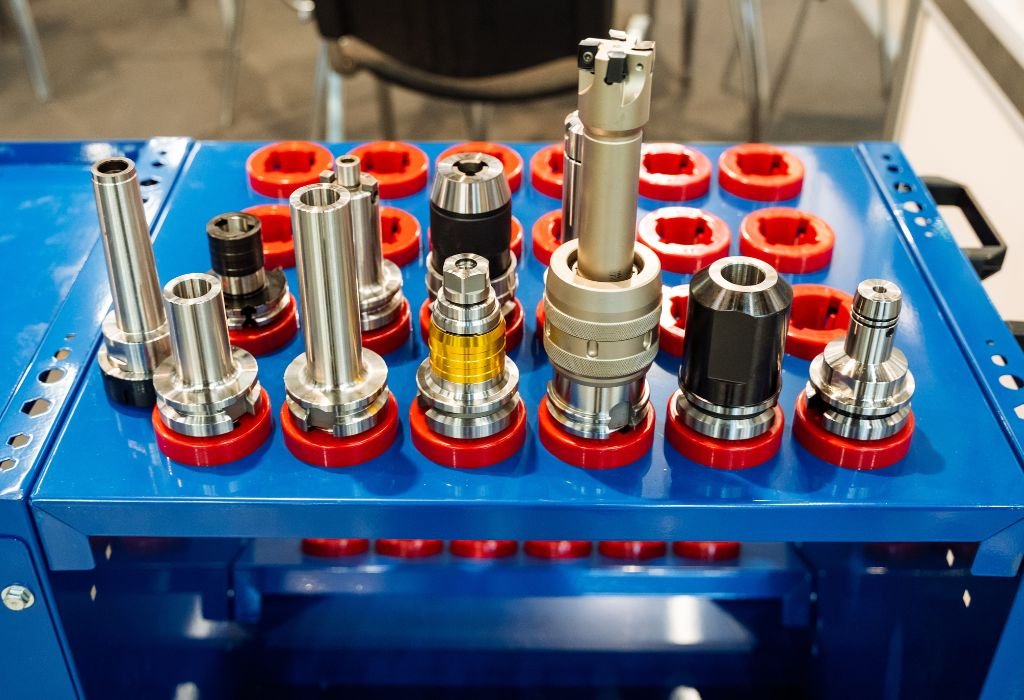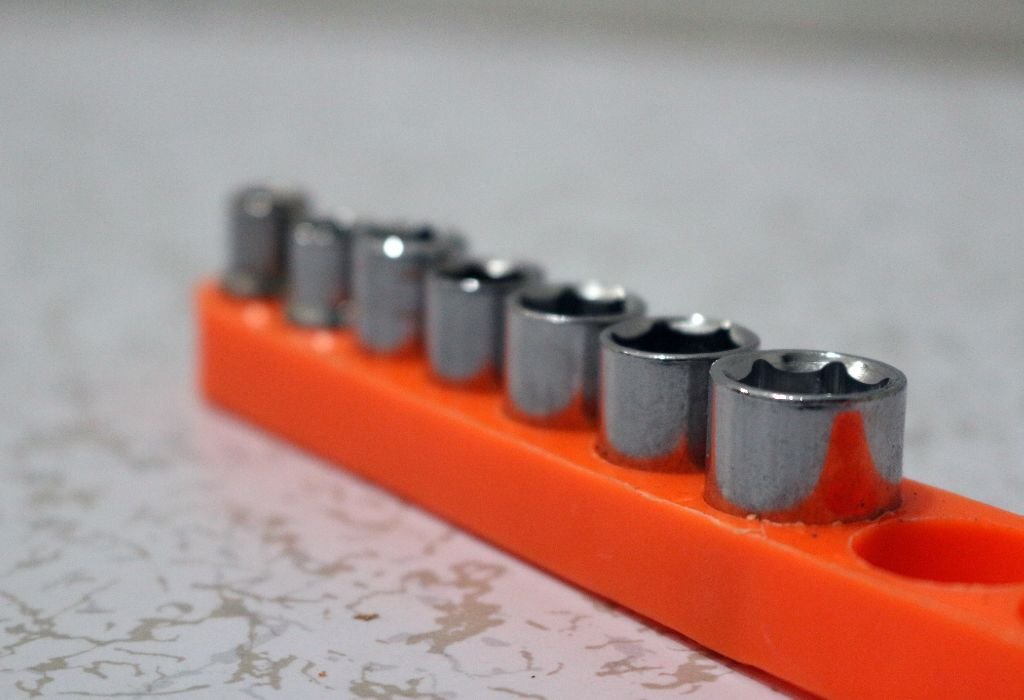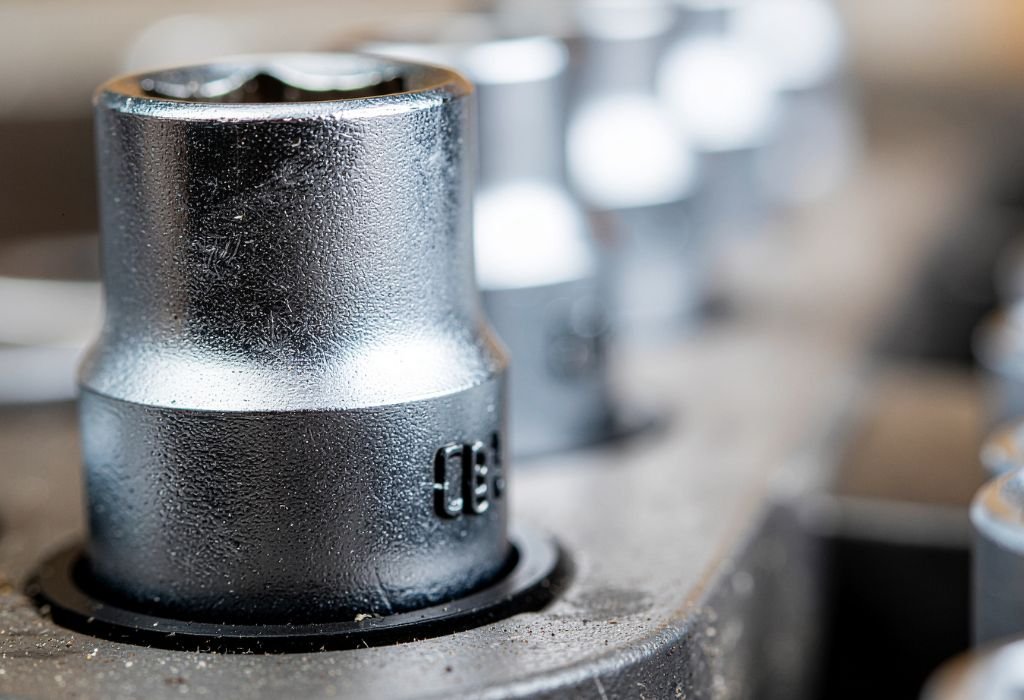Imagine a weekend mechanic staring at a stubborn bolt, impact driver in hand, and a shiny chrome socket nearby.
The temptation to use that regular socket is strong, but the consequences can be dangerous.
Impact drivers deliver power differently than hand tools. Instead of steady rotation, they apply rapid bursts of torque that shock the tool and the socket with every strike.
These sudden force spikes can exceed 1,500 to 1,800 inch-pounds of torque, enough to split brittle chrome-vanadium sockets not designed for impact use (BLS equivalent torque comparison sources).
Safety experts warn that non-impact sockets may crack or even shatter when exposed to these loads. Flying fragments pose risks not only to the user but also to nearby equipment.
Impact sockets are built differently. They use thicker walls, chrome-molybdenum steel, and a black oxide finish that resists fractures while absorbing shock energy.
The real question is not just about whether non-impact sockets will fit, but whether using them is worth the safety risks and potential tool damage. Many professionals already know the answer.
This guide explores what happens when non-impact sockets meet impact drivers, the engineering differences between socket types, and the safety standards behind them.
Readers will also learn about the risks, alternatives, and best practices for keeping both tools and users safe.
Impact Drivers vs. Hand Tools — Why Socket Choice Matters

Impact drivers operate differently from standard hand ratchets. Instead of smooth rotation, they use rapid bursts of torque that strike both the fastener and the socket.
These torque spikes create stress levels that hand sockets, usually made of chrome-vanadium, are not designed to withstand. Over time, this mismatch leads to cracks, chips, or sudden fractures.
Impact-rated sockets are engineered for this kind of punishment. They use thicker walls and more ductile metals to absorb shock loads without shattering.
The distinction between hand tools and impact tools is critical. Using the wrong socket with an impact driver can compromise safety and damage both the tool and the fastener.
Can you use non impact sockets with an impact driver?
They may fit, but the material is brittle and can shatter under impact forces.
What makes an impact driver different from a drill?
It delivers rotational blows combined with torque, not just steady spin.
Why do torque spikes matter?
They multiply stress levels instantly, pushing sockets beyond their design limits.
Can impact sockets be used on hand tools too?
Yes, impact sockets work safely on both impact drivers and manual ratchets.
Is this a safety or convenience issue?
It’s primarily a safety issue, since broken sockets can eject sharp fragments at high speed.
Material & Build — Cr-Mo vs. Cr-V, Wall Thickness, Finish
The biggest difference between impact sockets and non-impact sockets lies in the materials used. Impact sockets are typically made from chrome-molybdenum (Cr-Mo) steel, while regular sockets are made from chrome-vanadium (Cr-V).
Cr-Mo is designed for toughness and ductility. Cr-V is harder and shinier, but also more brittle under repeated shocks.
Wall thickness also differs. Impact sockets have thicker walls to handle shock loads, while non-impact sockets prioritize slim profiles for hand clearance.
Finish is another key distinction. Impact sockets use black oxide to resist corrosion and avoid flaking, while chrome sockets use polished plating that can chip under stress.
Why is Cr-Mo stronger for impacts?
It flexes without fracturing, unlike brittle Cr-V.
Does wall thickness matter in socket safety?
Yes, thicker walls prevent splitting under high torque.
Why do impact sockets use black oxide?
It prevents plating flakes and adds durability under shock.
Can chrome sockets resist corrosion better?
Yes, but corrosion resistance is irrelevant if the socket shatters.
Does heat treatment affect socket life?
Yes, proper heat treatment ensures toughness under repeated impacts.
Safety Risks of Using Non-Impact Sockets
Using non-impact sockets with an impact driver can be dangerous. The most common risks include cracking, shattering, and tool damage.
When a chrome socket fractures, sharp shards can eject at high speed. These fragments can injure hands, eyes, or anyone nearby.
Even if the socket doesn’t break immediately, repeated use weakens it. Over time, microscopic cracks spread until sudden failure occurs without warning.
The impact driver itself may also suffer. The anvil, detent, and bearings can be damaged by a socket that flexes or slips during use.
What is the worst risk of using non-impact sockets?
They can shatter violently, creating flying debris.
Can sockets fail without warning?
Yes, small cracks often go unnoticed until sudden failure.
Does PPE solve the safety issue?
No, safety glasses help, but only impact-rated sockets truly prevent shattering.
Can tool warranties be voided by misuse?
Yes, using non-rated sockets can void impact driver warranties.
Does slow trigger use make chrome sockets safe?
No, torque spikes occur regardless of trigger pressure.
Choosing Impact Sockets That Meet Standards

Not all sockets labeled “impact” are equal. Buyers should look for compliance with ASME/ANSI B107 standards for performance and safety.
True impact sockets list Cr-Mo steel, black oxide finish, and “Impact” clearly on the tool or packaging. Quality sets also include pin holes or detents for secure locking.
Shallow and deep variations exist for different uses. Deep sockets reach recessed fasteners, while shallow sockets fit tight spaces.
A professional set may include sizes from 1/4-inch up to 1-inch drive, depending on the type of work. For most impact drivers, 1/4, 3/8, and 1/2-inch drives are most common.
How can you confirm a socket is impact-rated?
Look for Cr-Mo steel, black oxide finish, and ASME/ANSI labels.
Which drive sizes fit impact drivers best?
1/4″, 3/8″, and 1/2″ are the most widely used.
Do deep sockets weaken performance?
No, but they may flex slightly under heavy torque.
Why are pin holes important?
They allow locking pins or rings to hold sockets securely.
Are 6-point sockets better than 12-point for impacts?
Yes, 6-point sockets grip flats and reduce rounding under torque.
Adapters, Extensions, and U-Joints — Keep the Chain Rated
Even if you use impact sockets, weak links can compromise safety. Adapters, extensions, and universal joints must also be impact-rated.
Non-rated adapters often twist or snap under impact loads. When that happens, the socket or driver can suffer damage too.
Impact-rated extensions use thicker shafts and are designed to absorb vibration. Universal joints also come in impact-rated versions to handle torque without failure.
If one piece in the chain is not impact-rated, the entire setup becomes unsafe. Always match impact-rated accessories with impact sockets and drivers.
Can chrome adapters be used on impact drivers?
No, they often snap and cause dangerous failures.
Do impact-rated extensions reduce tool damage?
Yes, they absorb shock and protect the driver.
Are wobble joints safe for impact use?
Only if marked as impact-rated.
What about thin-wall sockets for wheels?
Impact-rated thin-wall sockets exist for protecting rims.
Does one non-rated piece make the system unsafe?
Yes, the chain is only as strong as its weakest link.
Real-World Use Cases — Wheels, Rusted Fasteners, Construction
Impact sockets excel in automotive, industrial, and construction work. Their design allows safe removal of lug nuts, rusted fasteners, and structural bolts.
In automotive work, color-coded thin-wall sockets protect wheels while withstanding impact torque. In construction, impact sockets loosen structural bolts without rounding edges.
On rusted or corroded fasteners, the pulsing torque of an impact driver combined with impact sockets breaks stubborn connections cleanly.
These real-world examples prove that while regular sockets may fit, they are not designed for the punishment of high-torque impact use.
Are impact sockets best for lug nuts?
Yes, they prevent damage while handling high torque.
Do impact sockets work better on rusted bolts?
Yes, they reduce rounding and break seized fasteners.
Are torque sticks needed with impact sockets?
Yes, they help control torque on reinstallation.
Can impact sockets replace all sockets in a toolkit?
Yes, they can be safely used on hand ratchets too.
Do professionals ever use chrome sockets on impacts?
No, safety standards strongly discourage it.
Care, Inspection, and Replacement

Even impact sockets wear out over time. Regular inspection is critical to prevent failures.
Check for cracks, chips, or deformities before each use. Replace any socket that shows visible damage.
Black oxide finishes require light oiling to prevent rust. Proper storage in dry toolboxes also extends service life.
Impact sockets last longer than regular sockets under stress, but they are not indestructible. Care and replacement keep them safe and reliable.
How often should sockets be inspected?
Before each session of use.
When should a socket be replaced?
At the first sign of cracks, chips, or wear.
Does black oxide need care?
Yes, apply light oil to prevent corrosion.
Can impact sockets last longer than chrome?
Yes, when used correctly under impacts.
Should sockets be stored in cases?
Yes, to prevent rust and accidental damage.
Myths vs. Facts
There are many misconceptions about using non-impact sockets with impact drivers. Clearing them up keeps users safe.
“Chrome sockets are fine for light jobs.”
False. Even small impact bursts can cause fractures.
“Cr-V is stronger, so it’s better for impacts.”
False. Cr-V is harder but brittle, while Cr-Mo absorbs shock.
“Impact sockets are only for air tools.”
False. Cordless impact drivers also require impact-rated sockets.
“Impact standards don’t exist.”
False. ASME/ANSI B107 covers impact socket requirements.
“You can slow the trigger to stay safe with chrome.”
False. Torque spikes happen even with partial trigger use.
Conclusion — The Safe, Professional Answer
So, can you use non impact sockets with an impact driver? The answer is clear: you should not.
While they may fit, non-impact sockets are not built for the torque spikes of impact tools. They can shatter, damage tools, and put users at risk.
The safe and professional choice is to use impact-rated, Cr-Mo, black-oxide sockets that comply with ASME/ANSI standards. These protect tools, fasteners, and most importantly, the user.
Is the upgrade worth it?
Yes, safety and tool protection outweigh the cost.
What’s the best long-term choice?
Build a full set of impact-rated sockets and accessories.
Can one set work for both hand tools and impacts?
Yes, impact sockets are safe for both applications.
Final advice?
Do not risk safety with chrome sockets. Stick with impact-rated gear for every impact driver task.

I’m John F. Nicholas, the founder, lead writer, and drill enthusiast behind 101drill.com. With years of hands-on experience in power tools and DIY projects, I created this platform to share practical knowledge, expert tips, and real-world insights to help others master the art of drilling.
